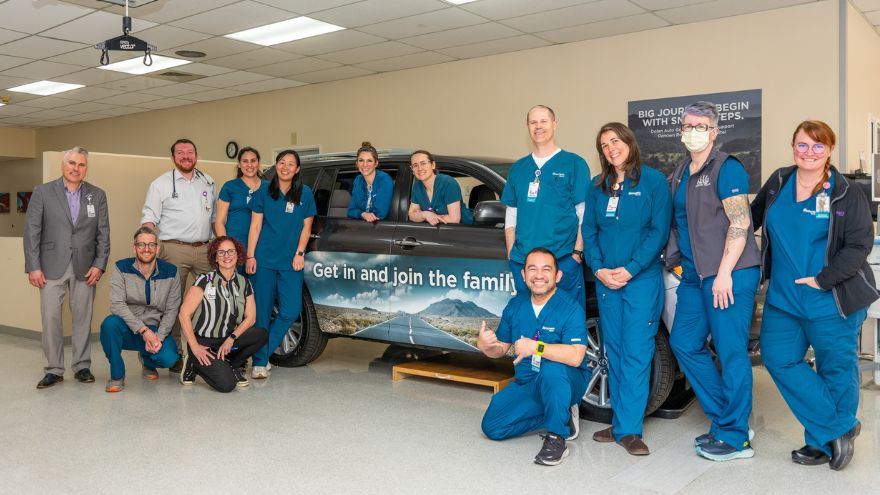Search
Results for 'what is an'
Clear-
Are You at Risk for Stroke?
Did you know an estimated 1.9 million neurons and 14 billion synapses are lost per minute during a stroke? That’s why every second counts. Anyone can have a stroke, but your chances increase if you have certain risk factors. That’s why the best way to protect yourself or your loved ones from a stroke is to know the risks and how to manage them. You can make changes to your lifestyle to lower your risk of stroke by asking yourself the following questions: 1. Is my blood pressure normal? High blood pressure is the leading cause of stroke and the most important controllable risk factor. If you’ve had a stroke, lowering your blood pressure can help prevent future strokes. 2. Can I quit smoking? Smoking damages blood vessels, clogs arteries and raises blood pressure — doubling your risk of stroke. If you want to reduce your risk of stroke and heart attack, quitting smoking is the first step — and Renown can help you with this. Learn more: Renown Health Quit Tobacco Program. 3. Do I make time to exercise 30 minutes a day? Many studies link consistent exercise habits with lower stroke risk. Also, being overweight contributes to high cholesterol, high blood pressure, heart disease and diabetes, all increasing your stroke risk. You don’t need to run a marathon — just commit to making time to move each day. 4. Do I regularly eat processed food and sugar? Eating less cholesterol and fat, especially saturated and trans fats, may reduce the fatty deposits (plaque) in your arteries. Also, eating five or more servings of fruits and vegetables per day may reduce your stroke risk. If you are diabetic, follow recommendations to get your diabetes under control.
-
Women and Stroke Surprising Signs to Know
Stroke is unfortunately common, with 1 in 5 American women experiencing it each year. When it comes to a stroke the phrase “time is brain” speaks to the urgency of getting rapid care. In fact, a woman may lose nearly 2 million neurons per minute of oxygen loss to the brain. The Renown Health Comprehensive Stroke Center experts share the importance of timely treatment and how stroke symptoms can differ in women. Women and Stroke – Surprising Symptoms Each year stroke affects more women than men. Even more concerning, women are less likely to recover from a stroke. The following non-traditional, less common, warning signs can be common in women: Hiccups with chest pain Sudden disorientation, drowsiness, confusion or a general altered mental status Nausea or vomiting A sudden headache that feels like the ‘worst headache of your life’ Unusual chest pain (especially with hiccups) Body numbness or weakness, such as an arm or leg suddenly ‘falling asleep’ Fainting or loss of consciousness Stroke Diagnosis The first step is neuroimaging by CT scan. This allows for rapid identification of any bleed, and also assists in determining candidacy for the early clot busting medication. MRI brain imaging is much higher resolution, and can better determine the core stroke size, assisting in prognosis and recovery. Since strokes have several different origins, an inpatient workup is essential to determine the underlying cause. Whether the stroke is secondary to plaque in the large vessels, clots being thrown in the setting of atrial fibrillation (an abnormal heart rhythm), or small vessel disease from years of uncontrolled vascular risk factors (high blood pressure, smoking, high cholesterol, diabetes), determining the cause is essential to implementing a management plan to reduce risk for further strokes. Quick Treatment for Stroke is Key Early recognition of stroke symptoms and seeking prompt attention is paramount. There are interventions that can be instituted to minimize the stroke and increase likelihood of recovery, but only if a patient presents to the hospital early. A clot busting medication, called tPA, can be given to patients with stroke if given within 4-5 hours from time of onset. Renown Regional Health Center is designated as a Comprehensive Stroke Center, the highest level of stroke certification available. To earn the designation of comprehensive stroke center, a hospital has to meet stringent requirements, including biannual on-site evaluations. This includes care for ischemic stroke patients (lack of blood flow), hemorrhagic stroke patients (bleeds), and determining the underlying cause to guide secondary stroke management prevention. Stroke Symptoms Remember “B.E.F.A.S.T.” to recognize the symptoms of a stroke below: B – Balance Being off balance or dizzy, is common. E – Eyes An eyesight change such as blurring or double vision may occur. F – Face droop One side of the face, or lip, droops A – Arm weakness Does one arm drift down? S – Speech Talking may slur or sound strange. T – Time Time to call 911. Call an ambulance immediately if you or anyone else, experiences any of these symptoms.
-
Stroke Survival as a Warrior – Kimi's Story
It seemed like a normal Wednesday, except Kimi Woolsey was feeling really stressed. On Sept. 4, 2019 she was rushing to get ready for an appointment when suddenly, she could not feel her legs. Kimi immediately knew something was wrong and called out to her fiancé, Paul, for help. After seeing a bright light in her right eye, she felt a severe, sharp pain in her head traveling down into her leg. Paul quickly called 911, the EMT’s arrived and her stroke survival journey began. At first the medical team thought she had a complicated migraine, but one of them suspected a stroke. On the way to the hospital Kimi felt numbness and her face drooping, then instantly, no pain. For a moment she thought she was dying, going from pain to numbness and realizing she couldn’t move or speak. Kimi didn’t know she was having another massive stroke in transit. Each year nearly 800,000 people in the U.S. suffer a stroke, or “brain attack” – that’s one every 40 seconds. Of those, about 75% occur in people over age 65. However, at only 45 years old, Kimi is proof that a stroke can happen at any age. Stroke Survival Begins for Kimi Upon arriving at the emergency department of Renown Regional Medical Center the Certified Comprehensive Stroke Center team went into action. Kimi received a brain MRI, then was wheeled into surgery for a thrombectomy (clot removal). She was in the intensive care unit for 11 days. She remembers someone telling her, “Generally people don’t survive this magnitude of stroke.” And a doctor saying, “You are here for a reason.” Kimi’s comeback journey began with the comprehensive care team at Renown Rehabilitation Hospital. “Literally I had the best day of my life that first day there…I was so happy because I couldn’t imagine being in a safer place with people that literally live for you,” she recalls. During her 41 days there, her biggest milestone was being able to get out of bed and walk. For Kimi the support she felt at the rehab hospital was key to her progress, ”I still feel loved and appreciated and they’re rooting for me still and I can feel it.” Although she left the rehab hospital on Oct. 18, 2019, she is still working on improving the left side of her body. Currently Kimi works with therapists in outpatient physical rehabilitation sessions, continuing to see improvement in both her hand and leg. Her advice to those currently in a rehab hospital setting is, “Stay as long as you can to get the most out of it and push, push, push.” Kimi’s Stroke Survival as a Warrior “Having a stroke is not for the faint of heart,” says Kimi. She experienced despair and felt discouraged. Many days she would ask herself, “Why am I here?” Today she proudly calls herself a stroke warrior and refuses to be a victim of her stroke. Alongside her tenacious spirit, Kimi actively helps others on their stroke survival journey. Before her stroke she never dreamed of starting a non-profit foundation. Now, each day you’ll find her texting inspiration to others, offering advice and connecting with other struggling stroke survivors on her Facebook page, Stroke Warrior Recovery Coach. Her goal is to become the person she needed to talk to after her stroke; she currently coaches several stroke survivors. “Stroke survivors need to know that they aren’t alone. Mental support and encouragement are so important for each person’s stroke journey,” Kimi said. Along with the physical changes, Kimi feels the stroke magnified her empathy. “I was always in a hurry in my life. People didn’t go fast enough for me – on the road, at the grocery store, in a line. Now I have more patience with myself and others." Kimi realizes most people cannot wrap their brain around the concept of a stroke. In fact, the brain fog, physical challenges and frustration are hard to explain… unless you’ve experienced them. “You need to find your tribe,” she explains. “I have a passion for helping people through this process.” Most of all, she encourages people to keep going and never stop. After her stroke, Kimi has a greater appreciation for her family, health and life. She is one of the patients featured in the current “Fight The Good Fight” trauma and physical rehab advertising campaign. “I wake up every day and fight,” she asserts. “Each day you have to fight for your recovery and fight for yourself.”
-
Tariqs Journey of Resilience at Renown Rehab
Pictured above are members of the interdisciplinary team at Renown Rehabilitation Hospital, representing the diverse array of caregivers who supported Tariq's recovery journey. For Tariq Kuraishy and his wife Melissa, the focus is on his journey and getting back to life as he knew it rather than the stroke he experienced in June 2024, which led him to Renown Regional Medical Center and later to Renown Rehabilitation Hospital (otherwise known as “Renown Rehab”). From the swift assessment by first responders to the immediate treatment at Renown Emergency Room and the critical care received in Renown's Intensive Care Unit (ICU), Tariq’s journey has been marked by resilience and exceptional support beyond the couple’s expectations. Navigating the First Moments After Stroke Melissa shared how Tariq’s care team’s calm demeanor and expertise eased the initial shock of his diagnosis, treatment and plan of care. For Melissa, staying informed during crucial care discussions was vital. She noted that the team's professionalism and reassurance gave her the confidence to let go of some of the mental and emotional burden she felt during the immediate period after the stroke, allowing her to focus on both her and Tariq's physiological and emotional needs. “I felt very safe being at Renown, knowing that we were being cared for to the greatest extent,” said Melissa. Rising to His Personalized Rehabilitation Plan Tariq began the Renown Rehab program on June 19 with one goal in mind: to regain 70% of his brain function within 30 days. To achieve this, he spends four to five hours per day participating in physical, occupational, speech and recreational therapies as part of a comprehensive rehabilitation program tailored to his specific needs. If that sounds like a rigorous schedule, it's because it is, but Tariq prefers it that way because it means he’s actively working towards regaining his sense of normalcy with his care team alongside him every step of the way. “Unlike other places that might take a more lenient approach, the responsibility for progress not only lies with the Renown Rehab team but also the patient. If you are prepared to do the work, Renown Rehab is prepared to get you there,” Tariq said. Melissa emphasizes that Renown Rehab provides comprehensive, whole-person care with a variety of innovative, individualized therapies. These therapies keep patients engaged and busy throughout the day, addressing not just the affected areas but also the entire body and mind, ensuring holistic recovery and facilitating progress in unique ways. Activities like catching a ball or putting a ball in a hole help restore function, much like restoring power to a building that has lost electricity. It’s All About the Support and the Team’s Know-How From the moment he arrived, the Renown Rehab team has been continuously assessing Tariq’s abilities and tailoring his rehabilitation plan to propel him to the next level. Melissa, who spends up to 12 hours a day at the facility supporting her husband, highlighted the daily therapeutic sessions as an impressive way the care team evaluates Tariq’s readiness for more challenging tasks. Communication between the couple and Tariq’s team of doctors, nurses, therapists, techs and certified nursing assistants is constant as they actively involve them in decisions. As Tariq put it, they don’t cater to his comfort zone but instead push for progress, understanding it may not always be linear. It’s a true collaboration. “It doesn’t feel like it's being done to us but being done with us,” Melissa said. Looking Ahead Tariq and Melissa feel immensely fortunate to be at Renown Rehabilitation Hospital, which offers an exceptional blend of equipment, technology and expert care teams. “The Rehab facility is a treasure,” Tariq said. “Every member of the care team has displayed the utmost level of professionalism and expertise, and there hasn't been a single person who hasn't shown compassion and competence,” Melissa added. “I feel I will get the most out of being at Renown Rehab. I plan to take full advantage of the services and use every bit of the team’s talent, training and expertise. I will not leave anything on the table,” Tariq said. As Tariq continues to progress, he and Melissa are optimistic about the future. Tariq continues to receive physical, occupational and speech therapy at Renown Rehab. Their journey, marked by determination and strong support from Renown, offers hope to others facing similar challenges.
Read More About Tariqs Journey of Resilience at Renown Rehab



